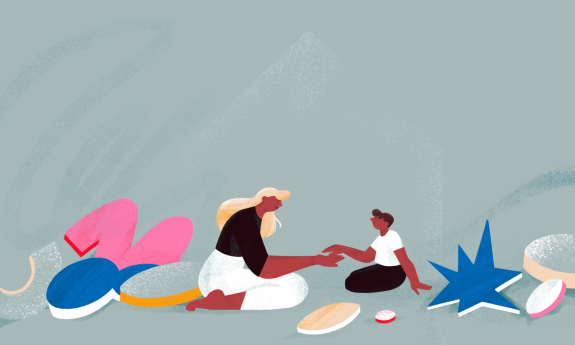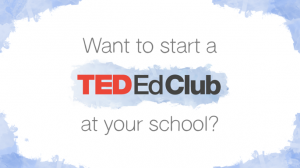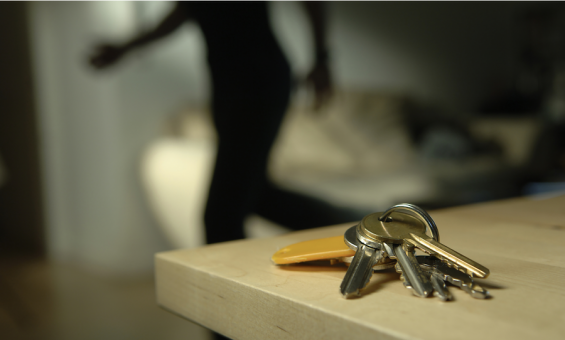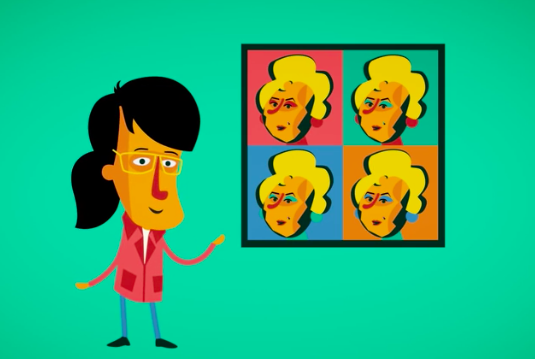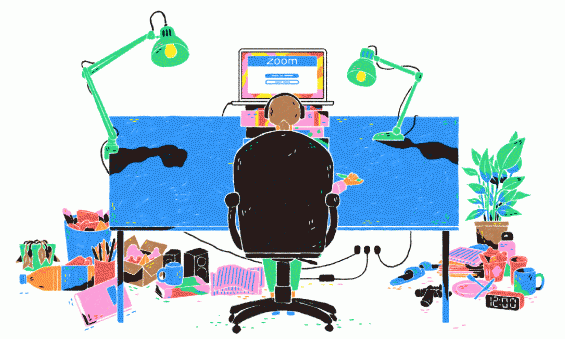
How to raise emotionally intelligent kids
I’d like you to take a moment and imagine you’re four years old.
You’re building a tower, and you’re really proud of it. But then the next minute another child comes running along and kicks over your tower. You are outraged, and you feel all these feelings bubble up inside — hurt, panic, frustration and helplessness. Just then, an adult comes by.
They get close, get down to your level, and ask: “Honey, what happened?”
In their eyes, there’s compassion and you feel that their body is calm and regulated. And then all those feelings come bubbling out of you — frustration, anger, helplessness.
This adult says: “Tell me all about it.” They don’t try and fix it, and they don’t say to you: “Don’t worry, you can build another one.” They just let you feel all that you’re feeling. Then they open their arms and you snuggle, take another deep breath, feel better and go back to building your tower.
If you were lucky, the adults in your life gave you lots of space to express how you feel without trying to fix what was going on.
Now I’d like you to try and remember being four years old and a time when you felt angry or sad or scared or you didn’t understand what was going on.
How did the adults in your life respond to you? If you were lucky, they gave you lots of space to express how you feel and listened to your worries and hurt without trying to fix what was going on.
But many of us probably had the opposite experience. Maybe we were told “Stop being so stupid” or “You don’t need to cry.” You might have been sent to your room or to the corner or even been hit for making a mistake.
We still value IQ far more than we value EQ.
Why am I talking about children and feelings? We’ve seen a steady increase in psychological distress among adults — in Australia and around the world. And I see this increase in distress as being rooted in part in the messages we received as children around how to express feelings and emotions.
Of course, it’s easy to blame our parents for what they did or didn’t do. But the real issue is the lack of emotional literacy in our culture. We don’t teach parents how to respond to children’s feelings and emotions with empathy and compassion. We also don’t teach it in our kindergartens; we don’t teach it in our schools. We still value IQ far more than we value EQ.
My work over the last 16 years with families around attachment, trauma and connection has shown me that there are usually three ways we learn as kids to deal with feelings and emotions.
You might have been labeled as “naughty”, “too much” or “trouble” when all you were doing was responding to your environment.
The first way is repression. Perhaps as a child, you learnt that it wasn’t safe to express your feelings. You might have gotten shut down and told to stop crying. Or you were given a look that made you draw everything inside and push them down deep. The impact of repression on a child is that those feelings stay there.
And then as adults, those feelings can turn up again when life throws us a curveball. Those same feelings come up, but this time, we respond by having another glass of wine or spending hours mindlessly scrolling through Facebook or making ourselves so busy at work that we don’t have time to feel .
The second way is aggression. As a child if we felt really powerless or scared and we grew up in an authoritarian environment where we didn’t have a voice and couldn’t say how we felt, then those feelings would again bubble up inside us. At the point where they would tip over when we felt most frightened or threatened, then they might come out in the form of aggression, rage, loud words. You might have been labeled as “naughty”, “too much” or “trouble” when all you were doing was responding to your environment.
And then as adults, those tendencies show up in bullying behavior. Or they can turn up in harsh critical thoughts about ourselves and others. Or it can show up as violence.
The third way is expression. If we grew up with an imprint that said “Feelings are welcome. I will accept all of you — the happy bits, the sad bits, the joyous bits, the bits that are angry. I’m not going to try and fix them; I’m just going to hold you,” then as adults when things feel hard, we reach for our journal and write down our thoughts. Or we call a friend and say: “Hey, can you listen to me?” Or we might go for a run, do some yoga, speak to our therapist and find a way to lean into the feelings, we feel them and let them go.
When I was a new parent, my game plan was “I’ll just keep them happy all the time.” But that’s a ridiculous thing to do.
I am a mother to three beautiful teenagers. When I first became a parent, like many of you, I had absolutely no clue about what I was doing. When it came to understanding their feelings and emotions, my game plan was “I’ll just keep them happy all the time.” But, as anyone who has kids realizes, that’s a ridiculous thing to do. It is impossible and incredibly exhausting to try to keep people happy all the time. So I learned that I needed to find a way to help my children thrive emotionally and also create harmony for them in our home.
I’m lucky enough to understand and study trauma, and I began to see that what we need as humans is a safe place to unpack all of who we are. We need boundaries and holding, but we also need empathy and compassion for those big feelings that rise within. Instead of trying to fix their problems and trying to make them happy all the time, I just got down low and said: “Tell me all about it.”
And I just listened. Sometimes there were tears; sometimes, rage or complaining. But every time my only job was to sit there and hold space for them.
What I began to see was emotional intelligence developing in my children.
How do we expect our children to have empathy and compassion for other people if we don’t show them how?
One evening, I realized just how powerful this was. I was making dinner but I also had to go teach a class so I was doing the hustle that most parents do.
I was just about to go out the door when my youngest daughter, who was five at the time, came into the kitchen. She looked unhappy, and I could see that she’s feeling some feelings. I actually turned to her and said: “Honey, do you think you could hold onto your feelings for a few hours?” Of course, she looked at me like, “Are you kidding?”
At that moment my middle daughter, who was then 10, walked into the room. She said, “I’ll listen to your feelings”, and I’m like “OK.” So my 10-year-old took the 5-year-old into the bedroom, and I thought, I’m going to be late for work because I need to see what happens here.
I stood outside their door, and I heard my 10-year-old say: “Tell me all about it.” And the five-year-old started crying and complaining about all the things that had happened at school.
The 10-year-old was going, “Oh that’s hard. What else?” And then there was more complaining and then more tears and giggles and laughter and they came out of the room.
I saw my 10-year-old and said to her, “Honey, how was that for you?” She looked at me and said, “Well, Mama, I just did to her what you do for me.”
At that moment, I realized that children can’t be what they can’t see. How do we expect them to have empathy and compassion for other people if we don’t show them how? How can we expect them to treat others with kindness and respect if they don’t know what that feels like in their own bodies?
I wonder:
— What would it be like if we actually supported parents with the tools and understanding to listen compassionately to their children?
— What would it be like if we actually helped parents unpack their own childhood, so they don’t have to carry that baggage and put it on their children’s shoulders?
— What would it be like if we supported and encouraged boys to cry and be vulnerable and girls to rage and find their voice and speak up for what they need?
— What if instead of harsh disciplines and punishments, we replaced them with compassionate listening and loving limits and boundaries?
— What would it look like if we took all of these ideas and placed them in our education system?
About 18 months ago, a colleague and I created Woodline Primary School. It’s set in the Geelong hinterlands on a beautiful farm with abundant nature. We have horses, chickens and veggie patches, and the philosophy of our school is to foster our students’ emotional well-being in a safe learning environment.
Sir Ken Robinson said the aims of education are to understand the world around us and the world within us. But what if we prioritized the world within?
Research shows that when children feel safe to learn — which means they feel free of judgment and criticism, they’re treated with kindness and respect, they have autonomy over their bodies and their learning, and they are given much love and celebrated for their unique differences — their neurological systems become fully operational and their capacity for growth and learning increases.
Our aim at Woodline is for children to learn about the world and also develop critical life skills such as emotional intelligence, growth mindset, critical thinking and a love of failure. Every time you fail, you realize, “Ah there are so many more options I haven’t yet explored!” More than anything, we want them to learn to be compassionate citizens of the Earth.
The late great Sir Ken Robinson said that the aims of education are to understand the world around us and the world within us. But what if we prioritized the world within? Surely, the world around us would make so much more sense.
Just think: How different could the world be if we placed connection, heart and compassionate listening at the center of every one of our relationships?
This post was adapted from a TEDxDocklands Talk. Watch it here:
ABOUT THE AUTHOR
Lael Stone is an author, speaker, parenting educator and consultant that specializes in helping adults process their childhood trauma. She is the cofounder of Woodline Primary School, cohost of The Aware Parenting Podcast and a mum to 3 grown-up children.
This post was originally published on TED Ideas. It’s part of the “How to Be a Better Human” series, each of which contains a piece of helpful advice from someone in the TED community; browse through all the posts here.
